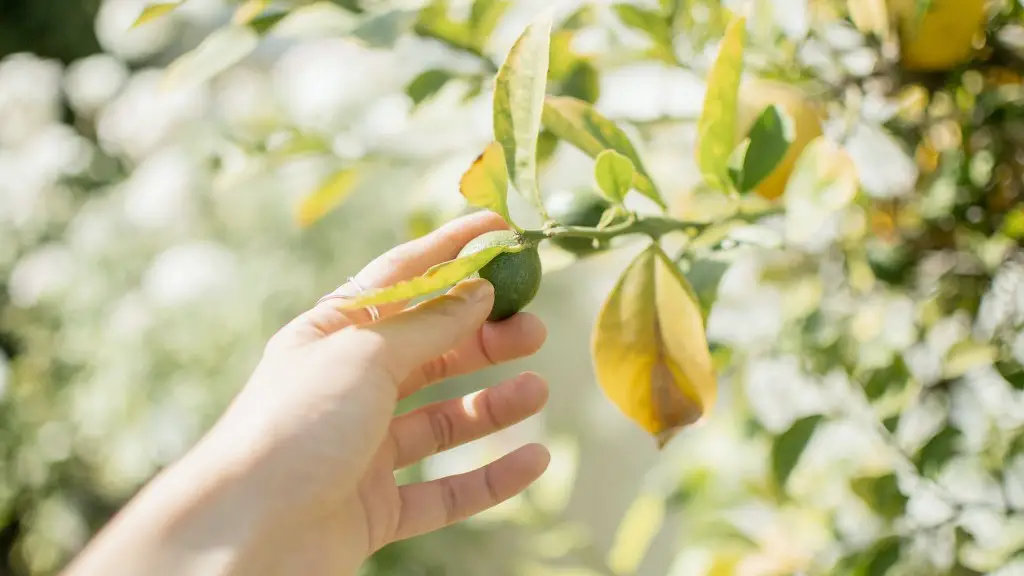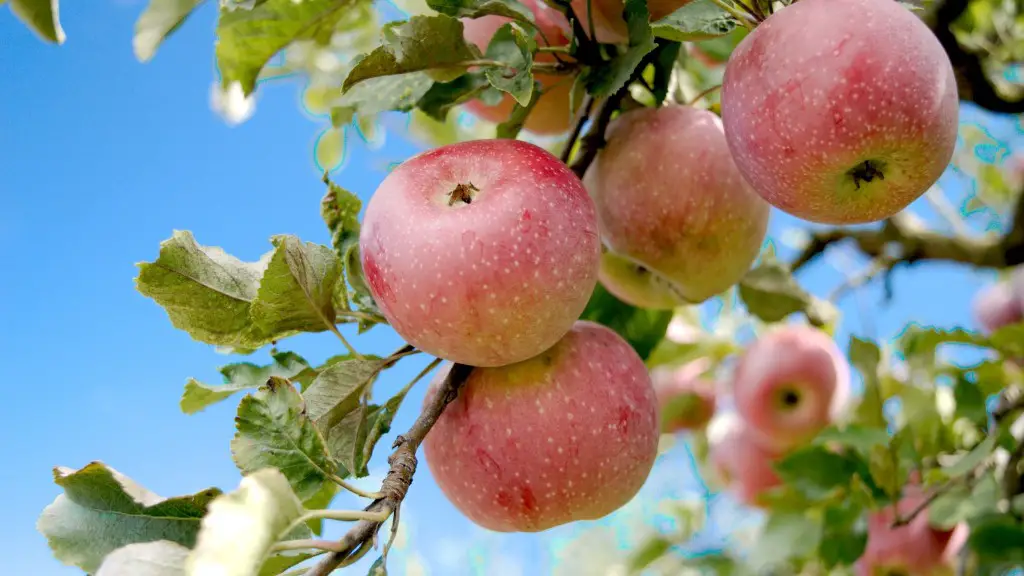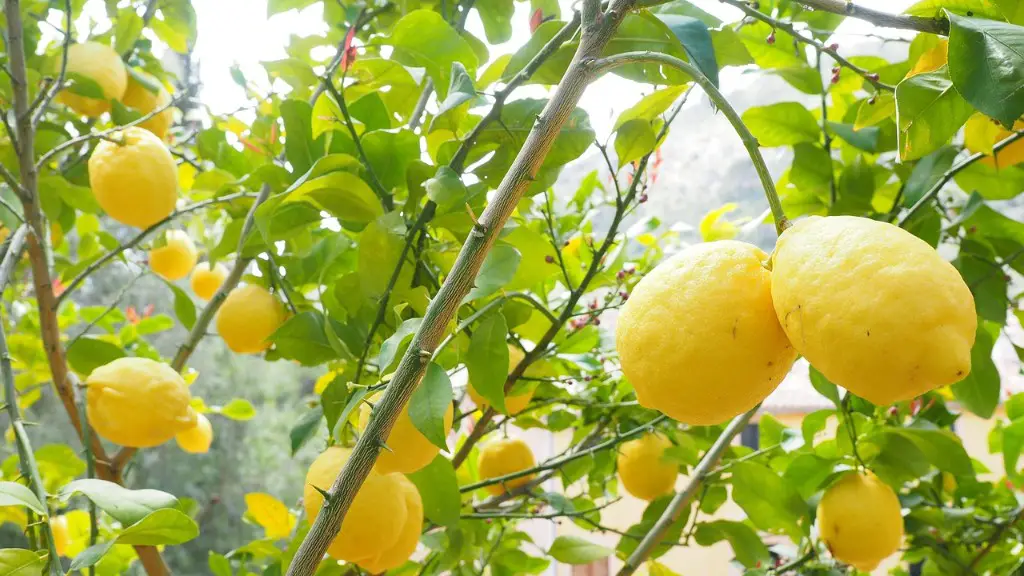Most lemon tree varieties, such as ‘Meyer’ and ‘Eureka,’ are similar in size and can grow from 4 to 6 m in height when mature. On average, citrus trees (of all varieties) require about 10-15 feet of growing space. The size of the lemon tree depends on how far apart the branches are spaced, the type of soil and the care given to it. Pruning is often done to control size and promote fruiting. For the healthiest lemon trees it is generally recommended to prune in the summer or early spring.
A lemon tree will naturally reach a mature height of around 5 or 6 m but this can vary depending on the variety of lemon, the environment the tree is planted in, and the amount of care it receives. Generally, lemon trees that are exposed to a lot of sunlight and that receive ample amounts of water are likely to reach larger heights. Furthermore, if the branches are left to grow multiple smaller clusters of leaves, the tree will become larger than if the branches are kept to a single cluster.
Caring for a lemon tree properly is key to keeping it a manageable size. If a tree gets too large, it can become stressed and produce less fruit. Spacing the branches slightly apart, pruning off excess branches and even roots, and removing diseased or dead branches can help promote a healthy, smaller tree. Pruning should be done with care, as too much pruning can shock a tree.
Essential to the size of the lemon tree is the soil it is planted in. Sandy loam or clay soils are most ideal and should have adequate drainage and air circulation. If a lemon tree is planted in a soil that is too rich or heavy, it can lead to excess growth and a larger tree. If the soil has too much moisture-keeping fungus, it can stunt the growth of the tree, leading to a smaller or unhealthy tree.
Finally, the type of fertilizer used on the lemon tree can also affect its growth. Excessive use of nitrogen-rich fertilizers can lead to rapid growth, while the use of potassium or phosphorus-rich fertilizers can help promote flowering and fruiting which can ultimately lead to a larger tree. Additionally, fertilizers with slow-release nitrogen can be used to help ensure the tree has a steady supply of nutrients to help it maintain a healthy size.
Pruning and Trimming
Pruning and trimming are important for the proper growth and size of a lemon tree. Pruning encourages healthy, fruit-bearing growth and removes dead or unhealthy branches. Trimming is the process of removing excess foliage, which promotes balanced growth and helps keep the tree from getting too tall. Trimming should be done with care, as incorrect pruning or trimming can lead to weakened growth or even stunted growth.
Summertime is typically the best time to prune and trim a lemon tree. At this time, the branches are full of healthy foliage and fruit. Aim to maintain an open center in the tree so that air and sunlight can reach the inner branches. Pruning off branches from the center of the tree should be avoided, as this can lead to a lack of flowers and fruit.
Pruning is also important for maintaining height control, as it helps a tree stop growing after it reaches a certain height. It is generally recommended to prune the tree in late winter or early spring, when it is just beginning to sprout new leaves and branches. Pruning the ends of branches or removing overgrown or crossing branches can help maintain balance and size control. Additionally, the arches and curves of the branches should be followed when pruning, as this helps promote aesthetically pleasing growth.
Lemon trees tame and small sizes also benefit from needling. Needling is the practice of pricking the branches with an awl or small pruning shears to produce a dripping of sap and stimulate healthy new growth. This practice can both restrict the lemon trees size and reduce the need for more drastic pruning.
Cage Pruning
Cage pruning is a technique often used to train a lemon tree to stay a certain size. Also known as “formative pruning”, this technique helps to control the shape and size of a tree without requiring drastic pruning. Cage pruning requires a series of wooden or metal stakes and straps which are used to form a kind of “cage” around the tree, allowing it to grow while still maintaining a certain size.
The stakes should be placed carefully around the tree in a manner that allows for maximum sunshine and airflow, while also restraining the direction of the tree’s growth. Once the stakes and straps are in place, they should be checked and adjusted several times over the course of a few years in order to ensure proper balance and shape.
Another benefit of cage pruning is that it prevents branches from dropping or breaking off due to natural shaking and wind, which can otherwise cause damage to trees that have been pruned too severely or abruptly. For mature trees that have been pruned too drastically in the past, cage pruning can help promote new growth and encourage a healthier root and branch structure.
Ultimately, how big a lemon tree will get depends on a variety of factors including its environment, type, and care. When properly managed, lemon trees can be a manageable size and will provide many delicious and nutritious lemons for a long period of time.
Fertilizing
Fertilizing a lemon tree is a key to keeping it healthy and promoting its growth. When fertilizing, it is important to use a fertilizer that is specifically formulated for citrus trees and to avoid fertilizers with too much nitrogen, as these can cause the tree to grow too quickly. The fertilizer should be applied once or twice a year, typically in the early spring and late summer, and it should be applied evenly around the base of the tree.
The amount of fertilizer applied will depend on the type and size of the tree. For a full adult size tree that has been established in the same place for at least two to three years, 3 to 4 kg of fertilizer should be spread over the soil area surrounding the tree. For younger trees the amount should be decreased to around 1 to 1.5 kg. Applying too little fertilizer can lead to a smaller tree and less fruit, while applying too much is likely to create more foliage than the tree can support and a larger tree than would be ideal.
Organic fertilizers such as compost are also an option when fertilizing a lemon tree. These fertilizers provide essential nutrients and can help to improve the soil’s drainage and aeration. These fertilizers should be applied about three times a year, in late winter, spring, and late summer. It is also important to keep in mind that organic fertilizers need time to break down before their benefits are fully realized, so they should be applied at least one month before they are needed.
Finally, mulching is another great way to help lemon trees thrive. Mulch helps to conserve moisture and moderate soil temperatures, and it can help to keep weeds out, reducing competition for nutrients and water. Mulch should be applied around the base of the tree in late winter or spring, at a depth of 5-10 cm. Organic mulches such as wood chips, straw, and leaves work best, as these will eventually break down and provide additional nutrients for the tree.
Watering
Regular watering is an essential part of caring for a lemon tree, as it helps the tree remain healthy, promotes new growth, and helps produce larger fruit. The amount of water needed will depend on the size of the tree, the soil it is planted in, and the surrounding environment, but typically a tree needs to be watered once or twice a week, with the frequency increasing with hotter or drier conditions.
Trees planted in containers typically need to be watered more often, as the soil in a container will dry out more quickly than that in the ground. The soil should always be moist but not soggy, so checking the soil before watering is essential. Over-watering can lead to root-rot, mildew and other diseases, so it is important to be cautious when deciding when and how much to water.
The most important factor when watering a lemon tree is the timing. Watering in the early morning is best, as the sun will help evaporate any excess water and the tree will have time to soak up the moisture before it gets hot. It is generally recommended to avoid watering in the evening, as the water will not have time to soak into the roots and can attract pests. Furthermore, watering too late in the evening can leave the tree exposed to cold temperatures which can be damaging or even lethal.
For those with limited water, there are a few ways to cut down on the amount of water needed. Applying a 2.5 to 5 cm layer of mulch around the tree’s base can help retain moisture in the soil, reducing the amount of water needed. Additionally, using a soaker hose or drip irrigation system can help ensure that water is getting to the roots without affecting other areas of the garden.
Pest Control
When caring for a lemon tree, pests should also be a concern. As with other types of citrus trees, aphids, scale, and mites are some of the most common pests. These pests can cause damage to the tree and the fruit, and in some cases even spread diseases. For this reason, it is important to be vigilant when looking for signs of pests.
One of the best ways to prevent pest infestations is to keep the tree healthy. Pruning away weak branches, applying mulch, and avoiding over-fertilizing can all help to keep pests away. Additionally, regular inspections can help catch potential problems before they become severe. Finally, there are a variety of natural or organic sprays or insecticides which can be used to target pests.
Some of the most common treatments for pests on a lemon tree include diatomaceous earth, neem oil, or insecticidal soap. These treatments are organic, non-toxic, and effective, and can be applied to the leaves, trunks, and branches of the tree without any significant harm. It is important to note, however, that these treatments can be hard on beneficial insects, such as bees and ladybugs, so it is important to use caution and only treat the tree as needed.
In some cases, it is also possible to manually remove pests from the tree. This usually requires using a brush to scrape away aphids or scale and can be particularly effective for small infestations. For more severe infestations, it may be necessary to cover the entire tree in a protective cloth or net to keep the pests away.
Conclusion
The size of a lemon tree can vary greatly depending on its environment, type, and care. Pruning, trimming, and cage pruning techniques can all help to control the size of the tree and promote healthy, fruit-bearing growth. Additionally, fertilizing and watering are essential for a healthy and productive tree, while pest control plays an important role in avoiding diseases and damage. With the right care and attention, a lemon tree will provide an abundance of delicious and juicy lemons for many years to come.




